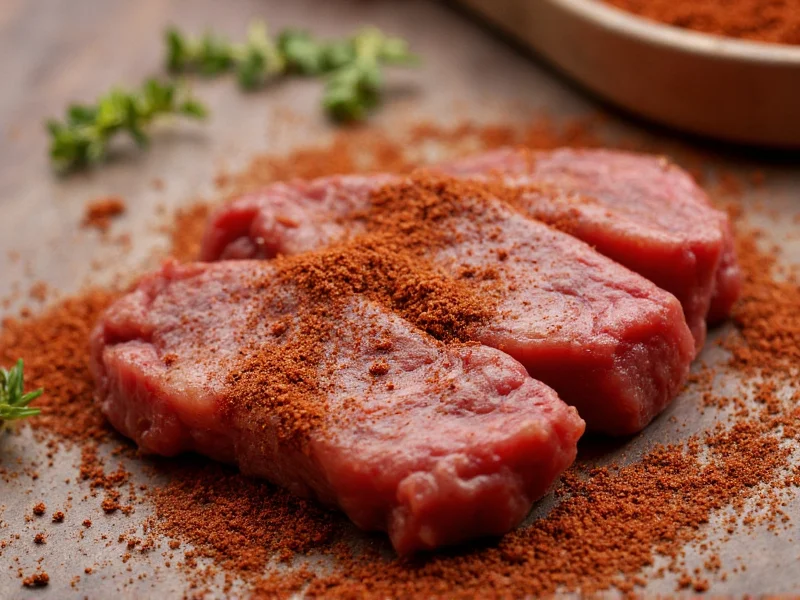Creating the perfect steak begins with understanding seasoning fundamentals. While many commercial blends exist, mastering basic steak spice seasoning empowers you to customize flavors for different cuts and cooking methods. The right combination enhances natural beef flavors without overwhelming them, creating a flavorful crust that locks in juices during cooking.
Essential Components of Steak Spice Seasoning
Effective steak seasoning relies on a balanced foundation. Salt serves as the cornerstone, not just for flavor but for its chemical interaction with meat proteins. Coarse kosher salt works best because its larger crystals dissolve slowly, penetrating deeper into the steak surface without making the exterior soggy. Black pepper provides aromatic complexity, especially when freshly cracked. Garlic powder delivers consistent flavor without burning like fresh garlic, while onion powder adds subtle sweetness.
| Core Ingredient | Recommended Amount (per pound) | Function |
|---|---|---|
| Coarse Kosher Salt | 1-1.5 teaspoons | Enhances flavor, improves texture, draws out moisture |
| Freshly Cracked Black Pepper | 1/2 teaspoon | Adds aromatic complexity and slight heat |
| Garlic Powder | 1/2 teaspoon | Provides consistent savory notes without burning |
| Onion Powder | 1/4 teaspoon | Contributes subtle sweetness and depth |
Customizing Your Steak Spice Blend
Different steak cuts benefit from tailored seasoning approaches. For richly marbled cuts like ribeye, a simple salt and pepper blend often suffices, allowing the beef's natural flavors to shine. Leaner cuts such as filet mignon respond well to additional flavor enhancers. When developing your homemade steak spice rub recipe, consider these specialized variations:
- Smoky Blend: Add 1/4 teaspoon smoked paprika per pound for cast iron cooking or grilling
- Herb-Forward Blend: Incorporate 1/2 teaspoon dried thyme and rosemary for tenderloin
- Spicy Variation: Include 1/8 teaspoon cayenne pepper for flank or skirt steak
- Simple Classic: Maintain the traditional 2:1:1 salt-pepper-garlic ratio for most applications
Timing and Application Techniques
When to apply seasoning to steak significantly impacts results. For optimal flavor development and crust formation, apply seasoning at least 45 minutes before cooking. This allows time for salt to dissolve and begin interacting with the meat's surface proteins. For thicker cuts (1.5 inches or more), consider seasoning up to 24 hours in advance and refrigerating uncovered—a technique known as dry brining.
The amount of seasoning per pound of steak matters more than many realize. Use approximately 1 teaspoon of total seasoning blend per pound of meat, adjusting based on personal preference and cut thickness. Press the seasoning gently into the surface rather than simply sprinkling it on—this creates better adhesion and more consistent flavor distribution during cooking.
Avoiding Common Steak Seasoning Mistakes
Even experienced cooks make seasoning errors that compromise steak quality. Adding salt too close to cooking time draws out moisture without allowing proper absorption, resulting in a less flavorful crust. Using fine table salt instead of coarse varieties leads to uneven distribution and potential over-salting. Including fresh garlic or herbs in dry rubs causes burning during high-heat cooking.
For those seeking steak seasoning without garlic powder, substitute with additional onion powder or a pinch of celery seed for similar savory depth. Remember that seasoning needs vary between grilling and pan-searing—outdoor grilling often requires slightly more seasoning to compensate for flavor loss to smoke and flame.
Creating Your Own Signature Blend
Developing a personalized steak spice seasoning requires understanding flavor balance. Start with the foundational salt-pepper-garlic base, then experiment with additional elements in small increments. Keep detailed notes about your steak seasoning for filet mignon versus ribeye, as different cuts respond uniquely to various spice combinations.
Store homemade blends in airtight containers away from light and heat to preserve potency. Properly stored, dry rubs maintain freshness for 3-6 months. For special occasions, consider toasting whole spices before grinding them for a more complex, restaurant-quality steak seasoning blend.











 浙公网安备
33010002000092号
浙公网安备
33010002000092号 浙B2-20120091-4
浙B2-20120091-4